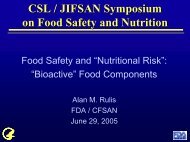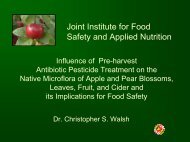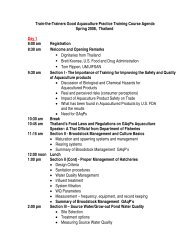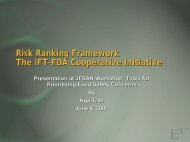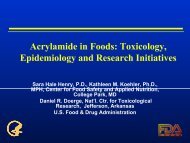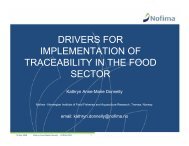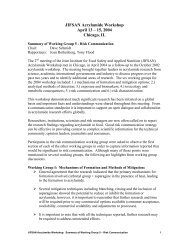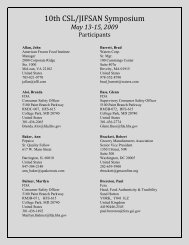Julie Miller Jones.pdf - jifsan
Julie Miller Jones.pdf - jifsan
Julie Miller Jones.pdf - jifsan
- No tags were found...
Create successful ePaper yourself
Turn your PDF publications into a flip-book with our unique Google optimized e-Paper software.
Chemical Risks in Our Food inPerspectiveJIFSAN May 2012<strong>Julie</strong> <strong>Miller</strong> <strong>Jones</strong>, PhD, LN, CNS,Academic Fellow of the ICCDistinguished Scholar and Professor Emerita,St. Catherine UniversitySt. Paul, MNWith credits to Carl K. Winter, Ph.D.University of California, Davis
Food Safety Risks in Perspective• Pesticides and Environmental Contaminants• Pesticides in imported vs. domestic fruits andveggies• The “Dirty Dozen” list of fruits and vegetablesconsumers should avoid• Safety of organic food relative to conventionalfood• Acrylamide• Arsenic and other heavy metals• BisPhenol A
Food safety priorities of FDA and WHO1. Microbiological contamination2. Nutritional imbalance3. Environmental contaminants4. Naturally-occurring toxins5. Pesticide residues6. Food additives
1 Environmental contaminants – includes pesticides*1 Food additives especially colors, sweeteners, chemical names that sound deadly*1 Microbiological contamination by industry (not in the home or by your raw milk orcheese seller or farmer at the farmer’s market)*2 Perceived nutritional ‘bad actors’ - trans, fructose, gluten *3 As and other things that are mention on Dr. Oz7 Heavy metals - Hg, As - if pregnant20 Obesity, diabetes, and diseases due to nutritional imbalance59 Naturally-occurring toxins*The ranking shifts with the current headlines
Definitions• Safety• Toxicity• Hazard• Vitamin A• Vinegar - ~1 qtAlle Ding' sind Gift, und nichts ohn' Gift; allein die Dosis macht, daß einDing kein Gift ist."All things are poison and nothing is without poison, only the dosepermits something not to be poisonous.” Paracelceus , 15335
Pesticides andEnvironmentalContaminantsEnvironmental WorkingGroup“Consumers can lower theirpesticide consumption bynearly four-fifths bysubstituting organic formsof the commodities on theDirty Dozen list”6
EWG - F &V to Be Avoided2012: Avoid conventionalforms of1 Apple 7 Grapes import2 Celery 8 Red Peppers3 Strawberries 9 Potatoes4 Peaches 10 Blueberries dom5 Spinach 11 Lettuce6 Nectarines import 12 Kale/collardgreens
EWG “Clean 15” - Lowest in Pesticides• 1 Onions• 2 Sweet Corn• 3 Pineapples• 4 Avocado• 5 Asparagus• 6 Sweet peas• 7 Mangoes• 8 Eggplant• 9 Cantaloupe - domestic• 10 Kiwi• 11 Cabbage• 12 Watermelon• 13 Sweet potatoes• 14 grapefruit• 15 mushroomsIf organic forms are unavailable, consumers are urged topurchase fruits and vegetables from the “Clean Fifteen”as substitutes 2011: “dirtiest” = apple; “cleanest” = onion
Checking Out EWG’s Claim• Data from USDA Pesticide Program• 6 indicators of pesticide contamination• % samples with detectable residues• % with 2+ detectable residues• Ave. # per sample• Average concentration of all pesticides found• Max. # on a commodity• Total # on a commodity• Summed up relative rankings from each indicatorto determine total scoreWinter CK, Katz JM.J Toxicol. 2011;2011:589674.
How Useful Is the EWG List• 10 most frequently detected pesticides• According to 2010 PDP data - 10 most frequentlydetected pesticides on produce compared with the“Dirty Dozen”• PDP ranking• 1 st Blueberries (#5)• 2 nd cherries (#9)• 3 rd kale (#10)HIGHEST exposure
How Dirty are the “Dirty Dozen?”Measured levels and calculated exposure• Compared with EPA reference doses•All exposures far below Reference Doses (RfD)• At least 100 lower than NOEL• > 0.1% Reference Dose 7/120•
• "We recommend that peopleeat healthy by eating morefruits and vegetables, whetherconventional or organic," saysKen Cook, president andfounder of EnvironmentalWorking Group. "But peopledon't want to eat pesticideswith their produce if theydon't have to. And with EWG'sguide, they don't."- Ken Cook, EWGPresident13
Pesticide Beliefs• 40% - believe the risk of pesticides in foodoutweighs the benefits of eating freshfruits & vegetables• U Mich survey• NHANES – organophosphate metabolites in urineof 1,139 kids 8 – 15 yrs• 95% excrete at least one byproduct• Those with highest levels were 93% morelikely to have received an ADHD diagnosisBouchard et al Pediatircs 2010; 125: e 1270-214
PESTICIDE RESIDUES - CONVENTIONAL VS. ORGANIC
Imported 48.8 percent of fresh fruits25 percent of fresh vegetablesconsumed in the U.S. - 2010DOMESTIC VS IMPORTED16
FDA Monitoring, 2003DomesticImportedWinter CK.J Agric Food Chem.2012;60:4425-9
RESULTS• 15 /18 pesticides detected on both• 11/15 higher for domestic F & V• 5 pesticides with highest exposures• domestic > imported exposures• Exposures in all cases were well belowEPA RfD
MethamidophosExample• Responsible for 39% of violations amongall 18 pesticides studied• 1 domestic violation vs 36 importedviolations• BUT all foreign were detected on commoditiesfor which no tolerance was established• Domestic exposure to methamidophos –1.7 times higher than imported exposure
2012 - Imported Food HasMore?• Modeling studies of pesticidespossibilities using amounts andsubstances allowed in othercountries• “suggested that a total of 120439 kg of excess pesticideresidue could be imported intothe U.S. if every exporter tothe U.S. followed theiroriginating country but not U.S.tolerances.”• Fussed about targeted Neff RA et al Global Health.sampling by EPA2012;8:2.20
ORGANIC VS CONVENTIONAL21
Sensory• Kansas state Univ. n=100• 72% of the subjects bought organic because it is“healthier”• 28% of them said that ‘organic food tastes better’before the test• “…organically and conventionally grown foodsdid not show a significant differences inconsumer liking or consumer-perceived sensoryquality.”Carey, E ”J Fd Sci. 72(2007) 87-9123
ORGANIC - PESTICIDE RESIDUES LOWER,BUT NOTZERO• Inadvertent contamination• Mixing and drift• 40% of UK Crops to have pesticides due to crosscontamination Worsley, L. Brit Fd J. 107(2006) 855-869• Pesticides found on the polar ice cap• Some “organic” growers may not followorganic rules
Organic Has More C• 27 varieties of spinach• Organic higher vitamin C (40.8 vs 25.7mg/kg) and flavonoids• Lower nitrates. Carrots, Bell peppers &Tomatoes – Poland• Organic increased carotenoids, phenoliccompounds and vitamin C• BUT variety and seasonalityHallman E J Sci Food Agric. 2012 Feb 20. doi: 10.1002/jsfa.5617.Sikora et al Rocz Panstw Zakl Hig. 2009;60(3):217-20.Hallmann E, Rembiałkowska E J Sci Food Agric. 2012 Feb 24. doi:2510.1002/jsfa.5624. Koh et al J Agric Food Chem. 2012;60:3144-50;
Organic Has Less C• Organic vs conventional, IPM - Italy• Lower vitamin C, lycopene, Cu• Higher Cd and Pb levels – It.• US - Tomato cultivar choice made moreimpact on vitamin C and antioxidants than• Cultivation method or seasonRossi et al Eur J Nutr. 2008;47:266-72.Aldrich et al J Sci Food Agric. 2010;90:2548-55;26
Vitamin C is the same• Green and red peppers- soil-less• vitamin C 52 – 80 mg/100 g (fw) similar inIPM and organic• Carotenoids highest insoil-less red peppersMarín A, et al J Agric Food Chem.2008;56:11334-41.27
No Difference in Bioavailability• 43 healthy men• apples (500 g/day; 4weeks) or no apples• No increasepolyphenolconcentrations inplasma and urinecompared controlsStracke BA, et al Eur J Nutr.2010;49:301-10.28
Organic More Alkaloids• Organic potatoes more bitter• Solanine and other glycolkaloids 50% higher• Research comparing plant toxins in organicvs. conventional foods - lacking• Differences may be greater than mostdifferences reported for nutritionally beneficialchemicals
Organic Yields Less• Conventional foods – 25% > yield• U Minn / McGill University -66 studies, 34crops.• Fruits / some legumes (e.g., chickpeas orbeans), organic farms 3-5% less• Seufert V et al Comparing the yields oforganic and conventional agriculture. Nature.2012.Are crop yields the Achilles heel of organic farming?• Organic agriculture can't compete with conventional interms of crop yields, according to a new study.• By Nora Doyle-Burr, Contributor / April 25, 2012Nathanson, A. Buyouts. 21(2008)28-3130
Acrylamide – Exposure Adults• Exposure est. adults μg/kg bodyweight/day• US FDA 0.4• WHO estimate 0.3 - 0.8• Health Canada 0.3 - 0.4• Sweden NFA 0.5• Holland NFC 0.48• Ave. daily dietary acrylamide intake ~21 μg/dSchouten et al . Am J Epidemiol. 2009 ;170:873-84; Tareke, AACC Sept 2003; Svensson etal, Food Chem Toxicol. 2003 41:1581-1586
Even those in thepopulation with the5% highest intakesingest levels farbelow the TDIClaes Oldenburg 1960s - he was wrong??Walker Art Center Minneapolis
UK FSA• “ Total intakes are so low that the FoodStandards Agency (UK) advises not to alter dietsor cooking methods of consumers.”• BREAD - n=192 - ave 30 μg/kg• 5 - 1987 μg/kg• Normal bread types (rye, wheat; white, wholemeal;loaf, bread rolls) seldom exceeded 30μg/kg.
Acrylamide – Reduction• FoodDrinkEurope toolboxDespite being a carcinogen in thelaboratory, many epidemiologicalstudies have reported that “everydayexposure to acrylamide in food is toolow to be of concern.”Tardiff eg al Food and Chemical Toxicology 2010;48:658-67.
Acrylamide – Reduction Strategies forBaked Goods and Toast• Toast lightly - Scrape off very dark or burnt areas• Bake at the right temperature; not too high• Golden not overbrown• Fiber in potato skin reduces effect• Allow long yeast-fermentation to asparagine in dough formation of acrylamide.• Leavening raises pH – • Salt, fat and gluten • Olive oil antioxidants Dobrowski et al Nutrition 2012. 28: 428-435; Rodríguez-Ramiro I, MartínMÁ, et al. Toxicology. 2011;288(1-3):43-8.
Calories and Nutrient intakes Associatedwith Acrylamide38% of calories• 33% of CHO•• 36% of fiber *Lunch 21%• 28% of fat• 20% of Ca *• 47% of Fe *• Coffee 36%• 25-35% of other micronutrients*• 15% of vitamin A• 34% of vitamin E *• 22 to 44% of B, C and folate** Nutrient of concern• Breakfast 8%• Dinner 22%• Snacks 13%Schouten LJ, et al: Results Fromthe Netherlands Cohort Study.Am J Epidemiol. 2009;170:873-84
Acrylamide – Take Out A Food• What happens to the Population Mean=0.37µg/kgbw-d - if you remove acrylamide from?• French Fries 0.26• Snack Food 0.31• Breakfast Cereal 0.33• Coffee 0.34Mean - µg/kgbw-dCSFII, 1994-96, 98, 2+ Population
Acrylamide vs AntioxidantProduct Trolox Equivalents/100g*Wheat Flour 1,000White Bread 1,600Bread, White 1,100Bread, Crust 2,050* Dry Weight BasisTOASTING PRODUCES SUBSTANTIAL ANTIOXIDANT ACTIVITY
Acrylamide, Coffee and HealthOutcomes• Cancer• Either no association• Or strong inverse associations• Inverse correlation with• Diabetes mellitus• Alzheimer's diseaseIs this really a dangerousprocess and should beavoided?Parkinsonism• Butt MS, Sultan MT. Crit Rev Food Sci Nutr. 2011;51:363-73; BeaudoinMS, Graham TE. Handb Exp Pharmacol. 2011;509-4841
Mercury and Fish• 1286 pregnant women, 522 postpartum women• 1349 non-pregnant/non-postpartum• Most aware of Hg• All groups
Arsenic31 rice samples - 60% US grown NYC stores• range 0.090 ± 0.004 to 0.85 ± 0.03 mg/kg• mean 0.275 ± 0.161 mg/kg• Samples with >0.20 mg/kg, n = 18 in vitro digestionExtractable - As 53 - 102%• Bioaccessibility• Extra long grain > long grain> long grainparboiled> brown riceHe et al J Environ Sci Health B. 2012;47:74-80.44
Arsenic : Se Interactions• Se As accumulation• Se oxidative stress from As and Cd• Sequesters As & Cd -inert conjugates• Se-dependent antioxidant enzymes detoxify• Se - potential countermeasure againsttoxicity induced by As and CdZwolak I, Zaporowska H. Cell Biol Toxicol. 2012;28:31-46.45
BPA & Food Packaging
BPA Exposure - Food Packaging• Polycarbonate plastic• Hard, plastic reusable bottles• Epoxy resins used in cans• Fear of BPA effects has• Created fear esp. amongyoung Mothers• Spawned a variety of BPA-freeproducts
European Food SafetyAuthority (EFSA)• “current safe intake levels forbisphenol A (BPA) should remainunchanged.” Oct 2010• Tolerable daily intake - set in 2006 reaffirmed‘08,’10• Present tolerable daily intake (TDI) of 0.05mg/kgbodyweight should be maintained. – decision of19/20 prominent scientists• Reviewed 800 studies over the course of 6 months
BPA - Infants 84 to 92% lessthan previously estimated• FDA 2012• 0.2-0.4 μg/kw-bw/day for infants• 0.1-0.2 μg/kg-bw/day for >2 yrs• BPA crossing the placenta too low for detection• Study orally dosed pregnant rodents with 100-1000times more BPA than people are exposed to throughfood, and could not detect the active form of BPA inthe fetus 8 hours after the mother's exposure.• Converted to inactive aglycone form => rapidlyexcreted (rodents have less excretion than primates)FDA’s National Center for Toxicological Research
Stump data – Denmark/ Canada• Uncertain effects onlearning ability BUT• Rat studies with highvariability in theresults and somemethodology issues
German Federal Institute (BfR)for Risk AssessmentTwo major studies showthe chemical is NOThazardous.• Stump et al and Ryan et al• No indications for adversehealth effects onneurological developmentand behavior• Yet - the Germanenvironment agencyasked industry andconsumers to findbisphenol A (BPA)alternate
BPA in Canned Food - Health Canada• ..urine of people whoconsume canned soup cancontain surprisingly highlevels of bisphenol A(BPA), a hormonedisruptingcompoundlinked to health problemsincluding heart disease,diabetes, and obesity.• BPA ~ all 78 cannedproducts tested• Canned tuna products– Highest• Average 137 ng/gMax 534 ng/g• Canned soups - 2 nd• Condensed 52 ng/g(Max94 ng/g)• RTE 15 ng/g(Max 34 ng/g)Cao XL, Corriveau J, Popovic S. JFood Prot. 2010;73:1085-9.
BPA in Canned Food - Health Canada• Tomato paste1.1 ng/g (Max 2.1 ng/g)• Tomato products 9.3 ng/g (Max 23 ng/g)• Average findings of BPA in the cannedfood products were consistent with thoseof past surveys and were not“considered to represent a humanhealth concern”.
A Word about Dose• Rats ≠ Humans - BPA metabolism andsensitivity to estrogens• Ig average is 57 ug/can, to get 50 mg/kgbw/day == 14 million cans of food orbeverage.
BPA Needed for Food Safety• BPA-based epoxy linings are a vital food safetytool• No fully tested alternative had yet been found.• Swiss Ministry of Health, Bundesamt fürGesundheit, : “A ban on BPA would inevitablycause manufacturers of packaging and consumerproducts (food contact materials) to have toswitch to other substances, the toxicity of which isless well known. This would mean a wellcharacterised risk would be replaced with aconspicuously unpredictable risk.”
Transfer from Baby Bottles• Worst-case scenario 0.8 μ/kgbw/dtransferred•
Australia / New ZealandFood Standards Australia New Zealand“levels of intake of BPA or plasticisers arevery low and do not pose a risk to babieshealth…”Is Your BPA Free Bottle Really Safe from theChemical? For five years, Dr. Brown’s NaturalFlow bottle has been a product American Babymagazine has described as a products ‘parentscan’t live without.’ But the award-winning BPA-freebaby bottle contained the highest traces of thetoxic chemical according to recent Health Canadatests. The Dr. Brown’s bottle showed trace
A Word about DoseIf 100's or 1000's ppb of endocrinedisruptor were "an actual health hazard”,then nobody should be eating wheatgerm or soy products, which containsignificant amounts of phytoestrogensthat are much stronger estrogendisruptors than BPA. And the same withbioflavanoids found in many fruits.To date there is no convincing datathat exposure to environmentalestrogens can be regarded as a riskfor human health
Next Set of Allegations - BPAand Immune DiseasesBPA postulated to havemany adverse effectsincluding beingresponsible forautoimmune diseasesChighizola C, Meroni PL.Autoimmun Rev. 2012;11:A493-50159
Risks - My Pipe Dream List forConsumers1. Buy, cook, store food safely2. Eat according to MyPlate – learn to cook3. Control portions4. Eat food that satisfies you in every way –ENJOY YOUR FOOD60
What We Know for SureIt ain't what you don't know that gets youinto trouble. It's what you know for surethat just ain't so.Mark Twain61
BPA and Metabolic Syndrome• Proven ways to reduce the risk of DiabetesMetabolic Syndrome• Exercise and Eat according to the Pyramid• 4 c of a variety of fruits and vegetables, prepared in avariety of ways including fresh, frozen, dried, canned• Eat 6 sv. of grain with emphasis on whole grains• Choose 3 sv. of low fat dairy• Choose nuts and legumes• Use salt sparingly• Avoid excess calories and saturated fats• Maintain normal weight





